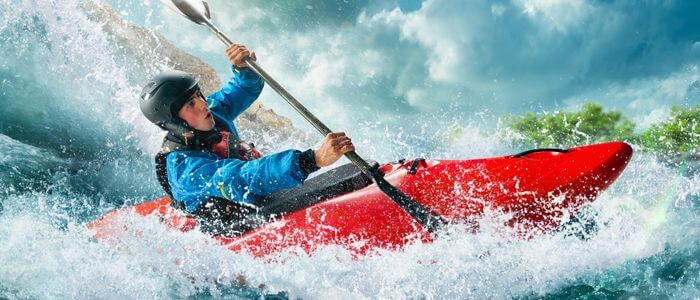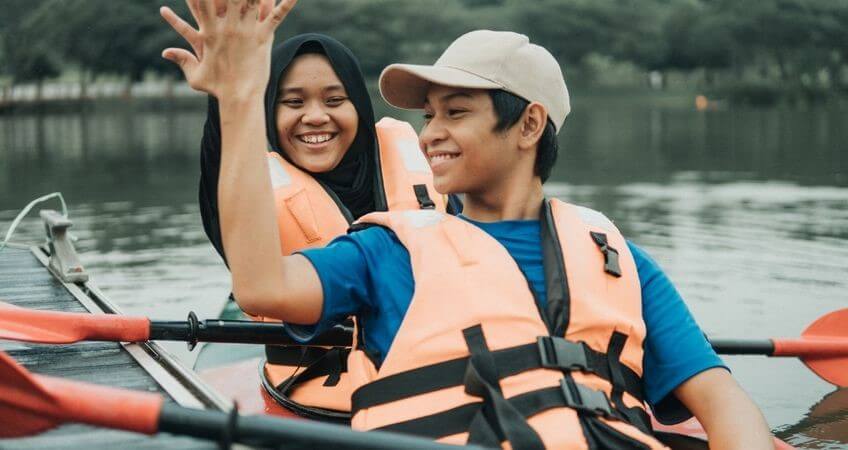
Kayaking is one of the most fun activities you can do on the water, but sometimes it can go wrong. Whether you are kayaking solo or with a partner, there are plenty of things that can happen to ruin your day. And the most common question that people ask is can you get stuck upside down in a kayak? So here I’m going to briefly answer this question.
You can get stuck upside down in a kayak if it tips over, but it doesn’t happen all the time. If you are riding a closed cockpit kayak or sit inside a kayak, you are more likely to get stuck upside down in a kayak. But, you can easily avoid this by following the guide written below.

You can get stuck upside down in a kayak if it tips over, but it doesn’t happen all the time. If you are riding a closed cockpit kayak or sit inside a kayak, you are more likely to get stuck upside down in a kayak.
It happens when the boat is tipped over while your body is still inside the boat. The boat will not be able to tip further because of the buoyancy, which makes it difficult for you to move out of the boat.
If you get stuck upside down in a kayak, you need to be quick about getting out as soon as possible, or you may end up drowning due to being immobile for too long.
The answer is No.
In fact, the vast majority of kayaks are designed to stay upright while they’re in use, and they’re even designed to keep their occupants safe. You may have heard that you should never turn a kayak upside down or that it will instantly capsize and drown you if you do. That’s not true!
This myth is simple: people have been getting into trouble by turning their boats over in shallow water or in areas where there aren’t enough waves to keep them upright. But even if you do manage to flip your kayak over completely, you’ll still be fine so long as:
But, you can still be stuck upside down in a kayak if it tips over. So, let’s learn how to avoid this while kayaking in your favorite spot.
The most important thing you can do is ensure that your kayak is the right size for your body. If it’s too big, you’ll likely flip over completely when you hit something. And if you are already wearing a life jacket, then all you have to worry about is not panicking.
But, there are 3 important things you can follow and avoid getting stuck upside down in a kayak.
Rough water is the biggest reason why people get stuck upside down. If you are new to kayaking, then avoid going out in rough conditions until you are confident about your skills. The best way to ensure that you don’t flip over completely is by not going too fast and ensuring that your paddle is at least as long as your arm span.
Rough water makes it much more difficult to control your kayak. And if you do flip over, it’s harder to get back upright again because the water is pushing against you. So, if big waves or wind are on your favorite spot, try going elsewhere instead.
Besides, rough water is a big no-no for beginners. Even if you have experience kayaking, avoiding paddling in rough water is best. The reason for this is simple; you don’t want to get stuck upside down in a kayak while trying to paddle away from a wave or current that’s taking you out of control.
BCDs are inflatable air chambers that help you stay afloat if you flip over in the water. They come in various sizes, so getting one that fits your body size and level of experience is important. If you’re just learning how to kayak, start with a high-quality BCD until you feel comfortable enough with the sport before upgrading to something other.
A buoyancy control device is a safety device that allows you to inflate or deflate the amount of air in your life jacket. This will help you stay at the surface if you fall out of your kayak. Besides, it allows you to inflate and deflate it, depending on how much air you need in order to stay afloat. This is especially useful if you are caught in rough water and need more flotation.
A kayak stability strip is a thin piece of foam that sits just behind the cockpit. It’s designed to help prevent you from falling out of your kayak or getting stuck upside down in your kayak, especially if you are caught in rough water.
If you have one in your kayak already, great! If not, consider investing in one before heading out on the lake. It will help prevent you from capsizing by increasing the surface area that touches the water.
So, it’s a simple addition to your kayak that helps you stay upright in the water. You can attach it by following the package instructions or using duct tape. It helps you stay balanced and upright so you don’t tip over when you paddle.
If you are new to kayaking, consider using one until you get used to it.
If you are new to kayaking, you may want to know what will happen if your kayak flips over. The answer is that it depends on a number of factors. If you are in a lake with calm water and there isn’t anyone around, then you may be able to flip back up yourself using the paddle as leverage.
When a kayak flips over, it can be a scary experience. You might lose your paddle and have to swim back to shore or call for help. The water is cold, so this could be dangerous if you are not wearing a life jacket. That is why you should always wear one when boating, but especially when kayaking, because the water level could be anything from high to low, and wearing a life jacket will help save your life.
There are many types of dangers that you may face when getting stuck upside down in a kayak. Let’s discuss some of them in detail.
When you are stuck upside down in a kayak, the water temperature may be very dangerous for your health. The water temperature in your area could be too cold for you to stay alive. If you are stranded upside down in a kayak, and there is no one around to help you, this could prove dangerous.
This is especially true if your body temperature drops below normal levels and hypothermia kicks in. So before going out on the water, ensure there are no extreme weather conditions like storms or hurricanes nearby.
Hypothermia is a condition in which your body temperature drops below normal levels. This is dangerous, and if left untreated, it can lead to death. If you are upside down in a kayak and there is no one around to help you, this could prove dangerous.
When you are upside down in a kayak, keeping your head above water takes more effort. This means that you will tire sooner than someone who is right-side up. If no one comes to help you and the cold temperatures begin to take their toll on your body, then this could lead to drowning.
This is especially true if you are not wearing a personal flotation device (PFD) or life jacket. So before going out on the water, make sure that you are wearing a life jacket and the water temperature is not that dangerous.
If you are new to kayaking, this could be a problem. If you are out in open water and begin to panic because of being upside down in the kayak, this could lead to trouble. The best thing that you can do is practice your skills in calm waters before going out into rough seas.

When it comes to kayaking, safety is the most important thing. You need to ensure that you wear a life jacket and know how to paddle before going out into open water. If not, you could get stuck upside down while kayaking.
If you are a beginner, then it is best that you take some time to practice your skills before going out into open water. You should also ensure that you have taken the right safety precautions and know how to handle yourself in an emergency.

Hey there kayak lovers! I’m Jay Schwartz, the author here at Kayak Guidance! You know water sports – you know me! My life is all about it. Kayaking, Paddleboarding, Fishing, Snorkeling and so much more. I love to share my passion and knowledge with all of you.

Hey there kayak lovers! I’m Jay Schwartz, the author here at Kayak Guidance! You know water sports – you know me! My life is all about it. Kayaking, Paddleboarding, Fishing, Snorkeling and so much more. I love to share my passion and knowledge with all of you.

Welcome to KayakGuidance.com! If you’re looking to have some fun outdoor water adventures, then you have come to the right place. We help our readers find the best kayaks and water related equipment to help you have the best time of your life whenever you are engaging in water activities.
This site is a participant in the Amazon services LLC associates program, an affiliate advertising program designed to provide a means for sites to earn advertising fees by advertising and linking to Amazon.com.